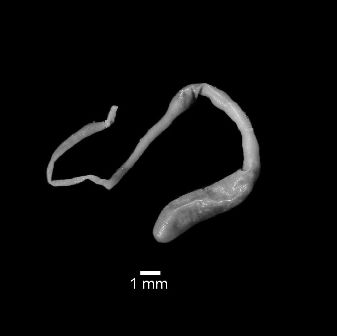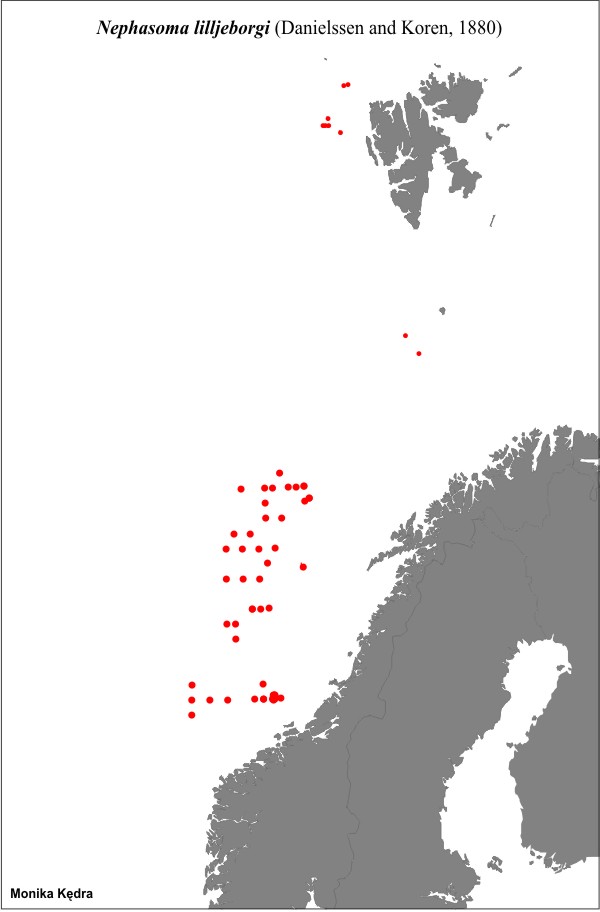Nephasoma lilljeborgi (Danielssen and Koren, 1880)
Arctic-boreal species common in deep-sea communities

Nephasoma lilljeborgi |

|
Phascolosoma lilljeborgi Danielssen and koren, 1880
Golfingia lilljeborgi Wesenberg-Lund, 1954
Distinguishing characteristics
Two retractors.
Smooth skin, body thin and transparent, with low skin bodies.
Oral disk is small, carrying two short tentacles and a few rounded lobes around the mouth.
Scattered, small, triangular hooks.
Might be easily mistaken with N. diaphanes or N. capilleforme
Size
Common trunk length: 10-15 mm
Maximum trunk length: 60 mm
Color
White to pale gray
Habitat
It inhabits sand, clay and mud
Feeding
Deposit feeder
Life cycle
Dioecious, probably trochophore larva
More Biology & Ecology
Nephasoma lilljeborgi often occurs with N. diaphanes in samples from the deep sea. They are very similar to each other, especially in the absence of gametes. However, N. lilljeborgi is more opaque and does not live in the foraminiferan tests. It is eurybathic species however, more common in bathyal bottoms.
Distribution
Far northeastern Atlantic Ocean from bathyal depths. Common in deep-sea communities; it might be endemic in cold deep waters.
References
- Cutler EB (1973) Sipuncula of the western north Atlantic. Bulletin of the American Museum of Natural History 152:103-204
- Cutler EB (1994) The Sipuncula. Their Systematics, Biology, and Evolution. 1-453
- Cutler EB, Cutler NJ (1980a) Deep-water Sipuncula from the Gulf of Gascone. Journal of the Marine Biological Association of the United Kingdom 60:449-459
- Cutler EB, Cutler NJ (1980b) Sipuncula collected by the R/V "Vema". Journal of Zoology (London) 190:193-209
- Cutler EB, Cutler NJ (1986) Revision of the genus Nephasoma (Sipuncula:Golfingiidae). Proceedings of the Biological Society of Washington 99:547-573
- Danielssen DC, Koren J (1881) Zoology. Gephyrea. The Norwegian North-Atlantic Expedition 1876 - 1878 1-57
- Fischer W (Fischer, 1895 256 /id) Die Gephyreen des Naturhistorschen Museums zu Hamburg. Abhaltungen aus dem Gebiet der Naturwissenschaften (Hamburg) 13:1-24
- Fischer W (1922) Gephyreen der Arkischen Meere. Wissenschaftliche Meeresuntersuchungen Abteilung Helgoland 13:229-246
- Fischer W (Wesenberg-Lund, 1929 184 /id) Die Sipunculiden, Priapuliden und Echiuren der Arktis
- Gibbs PE (1982) The synonymy of the Golfingia species assigned to the abyssorum-section (Sipuncula). Sarsia 67:119-122
- Gibbs PE, Cutler EB (1987) A classification of phylum Sipuncula. Bulletin of the British Museum Natural History Zoology 52:43-58
- Kędra M, Murina GV (2007) The sipunculan fauna of Svalbard. Polar Research 26:37-47
- Kędra M, Włodarska-Kowalczuk M (2008) Distribution and diversity of sipunculan fauna in high Arctic fjords (west Spitsbergen). Polar Biology 31:1181-1190
- Kędra M, Shields MA (2010) On the deep-sea Nephasoma species in the Eastern North Atlantic - A taxonomic guide, Marine Biology Research, DOI:10.1080/17451001003660293
- Murina GV (1977) Marine worms of the Arctic and boreal waters of Europe. Identification books of the USSR fauna
- Murina GV, Pancucci-Papadopoulou MA, Zenetos A (1999) The phylum Sipuncula in the eastern Mediterranean: composition, ecology, zoogeography. Journal of the Marine Biological Association of the United Kingdom 79:821-830
- Murina GV, Sorensen J (2004) Marine Worms of the Phylum Sipuncula in Faroese waters. Fr?dskaparrit 51:280-291
- Pancucci-Papadopoulou MA, Murina GV, Zenetos A (1999) The phylum Sipuncula in the Mediteranean Sea. 1-109
- Shields MA, Kędra M (2009) A deep burrowing sipunculan of ecological and geochemical importance. Deep-Sea Research I, 56, 2057-2064
- Théel H (1875) Etudes sur des Gephyreens inermes des ers de la Scandinavie, du Spitsberg et du Groenland. Kungliga Svenska Vetenskaps-Akademies Handlingar 3:1-30
- Théel H (1905) Northern and arctic invertebrates in the collection of the Swedish State Museum. I. Sipunculids. Kungliga Svenska Vetenskaps-Akademies Handlingar 3:1-30
- Wesenberg-Lund E (1930) Priapulida and Sipunculidae. Danish Ingolf-Expedition 4:1-44
- Wesenberg-Lund E (1938) The Godthaab Expedition 1928. Gephyrea. Meddelelser om Gronland 79:1-29
- Wesenberg-Lund E (1954) Priapuloidea, Sipunculoidea and Echiuroidea. Bulletin du Institute Royal des Sciences Naturelles de Belgique 30:1-18
